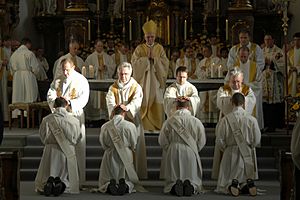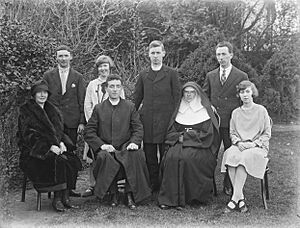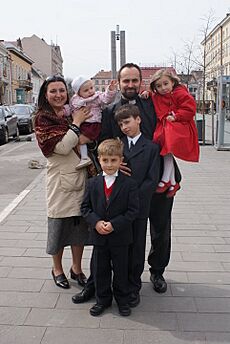Holy orders in the Catholic Church facts for kids
The sacrament of holy orders in the Catholic Church is a special way that some people are called to serve God and the Church. It's like becoming part of a special team that helps lead and guide the Catholic community. The word "holy" means "set apart for a sacred purpose," and "order" means an organized group. So, "holy orders" means a group with a special structure set apart for ministry in the Church.
There are three main levels, or "orders," in this sacrament: bishops, priests, and deacons. These three groups together make up the clergy.
Deacons are the first level. They can preach, perform baptisms, and witness marriages. They also help during Mass and can give out Holy Communion. Deacons cannot celebrate Mass themselves. Men who are studying to become priests usually become "transitional deacons" first. Others become "permanent deacons" and plan to stay deacons for life.
After being a transitional deacon for at least six months, a man can be ordained as a priest. Priests can preach, baptize, witness marriages, hear confessions, anoint the sick, and celebrate the Eucharist (Mass).
Some priests are later chosen to become bishops. Bishops are the highest level. They are the main leaders of large Church areas called dioceses. Bishops can also perform Confirmation and, most importantly, they are the only ones who can ordain (make) new priests, deacons, and other bishops.
Contents
Bishops
Bishops are chosen from among the priests. In the Latin Church, bishops must be unmarried. In some Eastern Catholic Churches, bishops must be widowers or unmarried, even though these churches allow married priests. Bishops are usually the main leaders of a diocese.
Only bishops can administer the sacrament of holy orders, meaning only they can ordain new deacons, priests, or bishops. Bishops also usually administer the sacrament of Confirmation. However, in Eastern Catholic Churches, parish priests administer Confirmation, often to babies right after their baptism.
Priests
The word "priest" comes from an old Greek word meaning "elder." The Catholic Church sees the Priesthood as connected to the ancient Jewish priests and to Jesus as priest. Priests celebrate Mass, hear confessions, baptize, witness marriages, and anoint the sick. They can also administer Confirmation if their bishop allows them.
Becoming a Priest
The ceremony where a man becomes a priest is called the Rite of Ordination. It happens during a Mass.
First, the men who are becoming priests are called forward. They promise to do their duties well and to obey their bishop. Then, they lie down in front of the altar while everyone prays for them during the Litany of the Saints.
The most important part of the ceremony is when the bishop silently lays his hands on each man's head. All the other priests present also lay their hands on the men. After this, the bishop says a special prayer, asking for the power of the Holy Spirit to come upon those being ordained.
After the prayer, the newly ordained priests put on their special priestly clothes, the stole and chasuble. The bishop then anoints their hands with holy oil called chrism. He also gives them a chalice (cup) and a paten (plate) which they will use to celebrate the Eucharist.
The Mass then continues, with the new priests celebrating the Eucharist alongside the bishop and other priests.
Deacons
Deacons are the first of the three main orders in the Catholic Church. The first deacons were chosen by the Apostles a long time ago, as told in the Bible (Acts of the Apostles chapter 6).
Deacons serve the Church in three main ways:
- Word: They proclaim the Gospel at Mass, preach, and teach.
- Liturgy: They help during Mass, give out Holy Communion, and can lead services like Benediction of the Blessed Sacrament.
- Charity: They help the poor and those in need, and encourage others to do the same.
Like bishops and priests, deacons must pray the Liturgy of the Hours every day. They can also baptize people and serve as the Church's witness at marriages. Deacons can lead funeral services outside of Mass and give certain blessings.
Minor Orders
For many centuries, the Catholic Church had four "minor orders" and one "subdeacon" order. These were steps that men took before becoming deacons. These orders were not considered sacraments. In 1972, these minor orders were removed to make things simpler. Now, only the orders of deacon, priest, and bishop remain as the main orders in the Latin Church.
Holy Orders
Holy orders is one of three Catholic sacraments that Catholics believe leave a permanent spiritual mark on a person's soul. The other two are baptism and confirmation. Only baptized men can receive the sacrament of Holy Orders.
Titles like cardinal or archbishop are not sacraments themselves. They are simply special jobs or positions within the Church, not new levels of holy orders.
Valid Ordinations
The Catholic Church recognizes that some other Christian churches have valid holy orders. This is because these churches, like the Eastern Orthodox, Oriental Orthodox, and Assyrian Church of the East, have kept the apostolic succession. This means their bishops can trace their authority back to the Apostles, just like Catholic bishops. So, if a priest from one of these churches becomes Catholic, his ordination is already considered valid.
However, the Catholic Church does not recognize the ordinations of ministers in most other Protestant churches. This is because these churches do not have the same unbroken line of apostolic succession.
Marriage and Holy Orders
In the Latin (Western) Catholic Church, men who become priests must be unmarried. However, married men can be ordained as permanent deacons. Sometimes, married non-Catholic clergy who become Catholic can be ordained as priests.
In the Eastern Catholic Churches and the Eastern Orthodox Church, married deacons can be ordained as priests. However, priests who are married cannot become bishops. Bishops in these Eastern churches are almost always chosen from among monks, who have promised to be unmarried.
Celibacy
Celibacy means choosing not to marry. In the Latin Catholic Church, priests and bishops promise to be celibate. This means they promise not to marry and to dedicate their lives fully to serving God and the Church. It's seen as a way to be completely devoted to God.
See also
- Ordination of women and the Catholic Church




